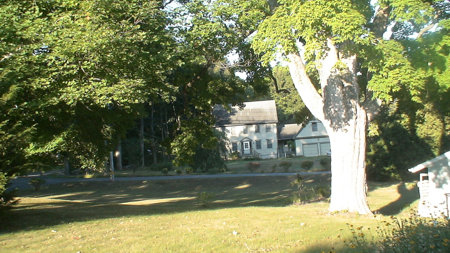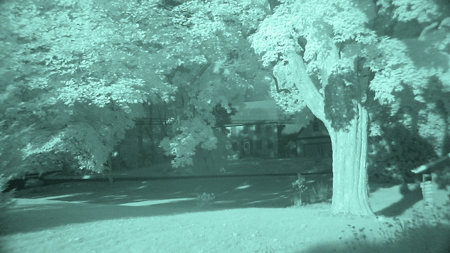Sony DCR-HC90 Camcorder
Comparing VIS and NIR Images from the Sony Camcorder
The following two images were taken on a clear late August morning. Both were recorded on the memory stick at full resolution (2016x1134). Auto focus was used. A tripod was used along with the Remote Commander trigger to reduce jiggle. For the NIR shot, NightShot was turned on and the X-Nite 1000 VIS-block filter was mounted.
 |
 |
| VIS - Visible image (click for larger image) | NIR - Near infrared image (click for larger image) |
Several differences between the two images can be noted:
- There is no ‘color’ in the NIR image. None of the three color sensors in the camera peak their sensitivity in the NIR so they cannot distinguish wavelength variations there. We must treat the NIR shot as a black-and-white photo.
- The leaves are much brighter in the NIR. This is a famous and important property of vegetation. Due to the automatic exposure control, everything else appears darker. The tree trunk that was over exposed in the VIS is well seen in the NIR. Its reflectivity is probably not much different in the two parts of the spectrum.
- The shadows are still very strong in the NIR; perhaps even stronger than in VIS. The NIR image gives you the feeling that it was illuminated by a searchlight. This is because there is little if any ‘skylight’ in the NIR. Molecules and small particles in the atmosphere scatter little of the sun’s radiation with wavelength longer than 800nm. To see this lack of skylight, find the small bright patches of sky in the upper middle parts of the VIS image. (Remember, the sun is behind us.) Note that these patches turn black in the NIR image. In VIS, if an object is in shadow, it still has some illumination by skylight. Not so in the NIR. It could only get illumination from other objects such as clouds, trees grass, etc. Note how dark the shadows are on the house.
- In the center of the scene is a clump of green leaves; part from a nearby tree branch and part from a distant tree. These are in shadow. In VIS they are both dark and difficult to distinguish. In NIR, the tree branch is bright and the distant tree is dark. This because the branch is receiving reflected NIR illumination from the bright grass in the foreground. The distant tree has no such illumination. Note also how the distant bushes along the road disappear in the NIR; more evidence of the lack of skylight.
- The NIR scene has a poorer focus and a slightly smaller field of view. Note that the image appears to zoom in and out slightly when you flip from one image to the other. Note also that small objects just seen at the edge of the VIS image are lost outside the NIR image. These differences probably arise from the different index of refraction for VIS and NIR. The lenses in the camera that use refraction for focusing were designed and optimized for the VIS. They are not as good in the NIR. I don’t think we are near the Rayleigh limit for resolution.
We have only discussed the differences between VIS and NIR in this particular scene. Other scenes with clouds, haze, water, soil, conifers, distant mountains, etc. will exhibit different properties. Do your own experiments!
